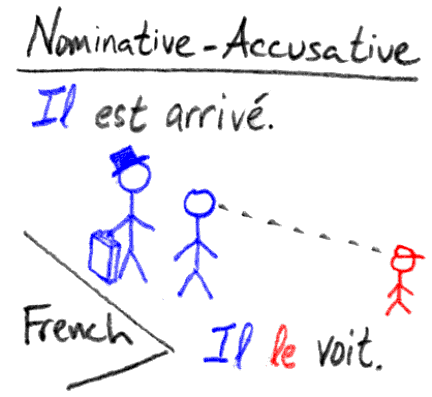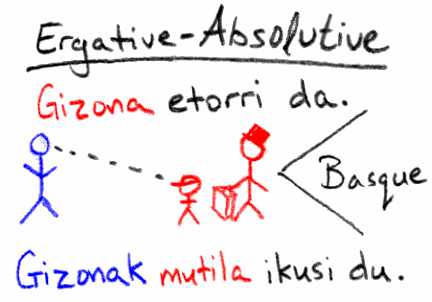Cartoon Theories of Linguistics
Part B—Ergativity
Phineas Q. Phlogiston, Ph.D.
Unintentional University of Lghtnbrgstn
As set forth in the previous installment (on non-configurational languages), our goal is
Mein Luftkissenfahrzeug
ist voller Aale
— German
|
|
|
to illustrate important concepts in linguistics via cartoons. (And, as mentioned last time, in so doing perhaps illustrate our own mastery of the material!)
For our next foray into the Cartoon Theory of Linguistics, I present the following visual explanation of ergativity:


Моё судно на воздушной
подушке полно угрей
— Russian
|
|
|
Next time, we’ll look at morphological typology.
References
- Anderson, Stephen R. (1985). Inflectional morphology. In T. Shopen (Ed.), Language typology and syntactic description: Grammatical categories and the lexicon (Vol. 3, pp. 150-201).
- Comrie, Bernard. (1978). Ergativity. In W. P. Lehmann (Ed.), Syntactic typology: Studies in the phenomenology of language (pp. 329-394).
- Dixon, R. M. W. (Ed.) (1987). Studies in ergativity.
- Dixon, R. M. W. (1994). Ergativity.
- Foley, William, & Van Valin, Robert. (1984). Functional syntax and universal grammar.
- Mallinson, Graham, & Blake, Barry J. (1981). Agent and patient marking. Language typology: Cross-linguistic studies in syntax (Chap. 2, pp. 39-120).
Meu hovercraft está
cheio de enguias
— Portuguese
|
|
|
- Plank, Frans. (Ed.). (1979). Ergativity: Towards a theory of grammatical relations.
- Schachter, Paul. (1977). Reference-related and role-related properties of subjects. In P. Cole & J. Sadock (Eds.), Syntax and semantics: Grammatical relations (Vol. 8, pp. 279-306).
- Silverstein, Michael. (1976). Hierarchy of Features and Ergativity. In R.M.W. Dixon (ed.) Grammatical Categories in Australian Languages (pp. 112-171).

